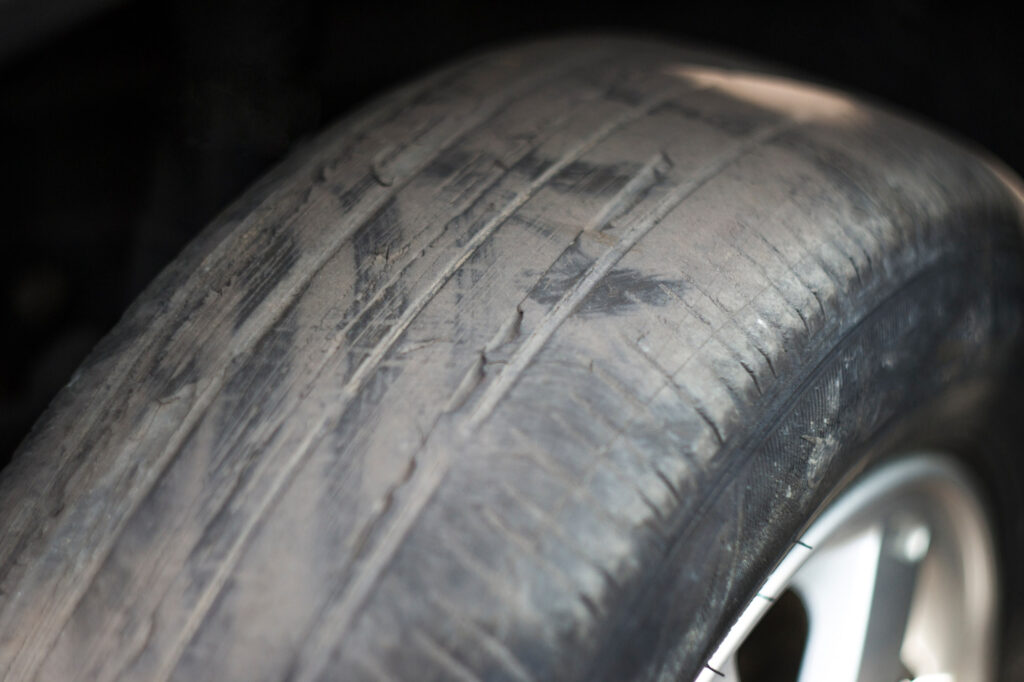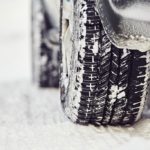Balding tires are tires that have minimal or no tread left. Visually, they look smoother than newer ones, but they are more dangerous on the road. If you’re unaware of what causes them and their symptoms, you might fall victim to the risks of driving with balding tires.
What Causes Bald Tires?
Some common reasons for tires to bald are improper air pressure, misaligned tires, and general wear and tear.
Improper Tire Pressure
The air inside the tires carries the car’s weight, so it’s crucial to maintain the proper tire pressure. Overinflation usually results in center tire wear (balding in the middle) since the middle drags on the ground.
Meanwhile, underinflation typically results in edge tire wear or balding on the tire’s outer edge.
You can find the manufacturer’s recommended tire pressure on the owner’s manual, the tire itself, and on a sticker inside the driver’s door. Generally, the recommended tire pressure is around 30 PSI for small cars, 36 PSI for midsize cars, and 42 PSI for large vehicles.

Misaligned Tires
Weight must be evenly distributed among the four tires on your vehicle, so they all make equal contact with the road when driving. Misalignment happens when the balance between the four is thrown off.
This leads to a handful of different issues, such as balding or rapid tire wear, because there’s a chance only one side is carrying the car’s weight and has more contact with the rough asphalt. The rough and concentrated friction gradually erases part of the tire’s rubber and tread.
General Wear and Tear
Tires will naturally wear down due to the friction generated by being on the road at high speeds. Their average lifespan is between three and five years, and it’s highly advised to replace them once they’ve run their course.
Symptoms of Bald Tires
Some symptoms of a balding tire include visible wear bars, low tread, cracks/bulges, and shaky tires.
Visible Wear Bars
There are bars between the treads of your tires that are designed as wear indicators. Once these become visible, it’s time to replace your tire.
For years, conventional wisdom was to test your tires’ tread depth using the penny method.by taking a penny and placing it into a groove tread upside down (Lincoln’s head first). More conventional studies have shown the penny method isn’t adequate and you should use a quarter and the top of Washington’s head.
Using the quarter method, if you can see the top of Washington’s head, the tire is below the minimum tread depth. Replace the tire immediately as it is considered unsafe to drive.

Cracks and Bulges
Cracks on the tires indicate they’re breaking down and are close to balding. They form naturally because the rubber reacts to friction, UV light, chemicals, and other road debris.
Once these cracks form, it should indicate that the tires are close to breaking down and almost unusable. The best action is to throw them away and find replacements as soon as possible.
Shaky Tires
Wear issues precede balding, which then leads to shaky tires when driving. This often occurs when the tires are imbalanced because one is significantly more worn down than the rest. You can combat this issue by aligning the tires, occasionally performing a visual inspection, and addressing cracks or punctures immediately.
Effects of Bald Tires

Some dangers of driving with bald tires are poor brake performance, increased braking distance, reduced vehicle control, and increased risk of a tire blowout.
Poor Brake Performance
Slamming on the brakes stops the wheels from turning, but it’s the traction from the tire treads that breaks the vehicle’s momentum. Therefore, a balding tire can reduce your braking system’s ability to quickly slow down your vehicle and bring it to a stop when needed.
Increased Braking Distance
Braking distance is the short distance your car travels between the moment you step on the brakes and the time your car comes to a halt. Bald tires significantly increase this distance because of the lack of grip on the road.
This may increase your chances of being involved in a rear-end collision during adverse weather conditions, as the roads tend to get slippier.
Hydroplaning and Reduced Vehicle Control
Most tires are designed to displace water, exposing the road surface for the tire treads to get a better grip on the road.
If the treads are almost gone due to balding, your vehicle will hydroplane and become difficult to control when driving over wet surfaces.
Increased Risk of Punctures
A balding tire is thinner than newer ones because of the lack of tread. This makes it more susceptible to punctures, as even the most random stuff on the road can rip the rubber open when driven over at high speeds.
Tire Blowout
Punctures lead to another issue: the increased likelihood of blowing out or the sudden loss of air pressure. The thinner nature of bald tires, paired with other factors, such as underinflation, could spell disaster when driving out on the road.
The lack of tread could also cause the tire to overheat, which is another cause of blowouts. To prevent them from happening, ensure you have the proper PSI to limit balding and overheating.
You May Get Fined
Some states have laws that impose a minimum required tread depth. In California, the minimum depth is at least 1/8th of an inch for the front tires and 1/16th of an inch for the rear tires.
You may get a ticket for this violation. The base fine is $25 for each bald tire and additional court assessment fees. So unless you’re willing to fork up that amount of money, it’s best to replace bald tires once they start showing the symptoms listed above.
Any information provided on this Website is for informational purposes only and is not intended to replace consultation with a professional mechanic. The accuracy and timeliness of the information may change from the time of publication.






























